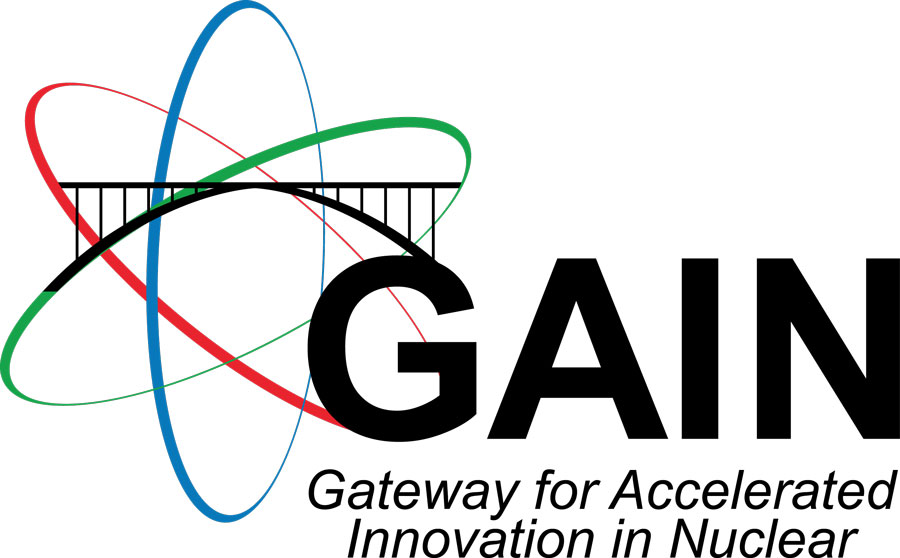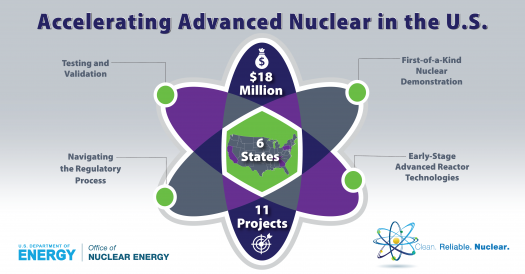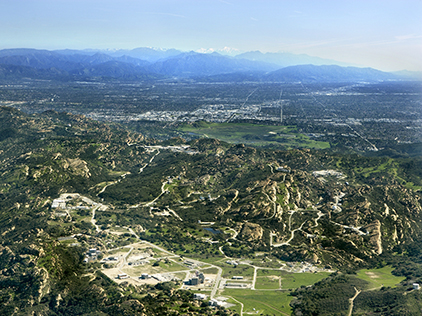Part 2 of 2 Parts (Please read Part 1 first)
The Integrated Risk-Informed Condition Based Maintenance Capability and Automated Platform will be carried out by a team comprised of Public Services Enterprise & Group (PSE&G) Nuclear, LLC, Idaho National Laboratory, and Rolls-Royce North America of Moon Township, PA. They are working on an automated platform for pilot implementation of a fully integrated risk-informed condition-based maintenance capability. It is hoped that this project will result in significantly reduced O&M costs associated with time-based maintenance for the U.S. nuclear fleet.
The Regulatory Assistance Grants pathway will provide support for resolving design regulatory issues, regulatory reviews of licensing topical reports or papers and other efforts focused on acquiring certification and licensing approvals for advanced reactor designs and capabilities.
The TEUSA-USNRC Pre-Licensing Activities for the Integral Molten Salt Reactor (IMSR®) of Terrestrial Energy USA in New York, NY will be funded under this pathway. This project will conduct pre-application interactions with the U.S. NRC to assist in the licensing of the IMSR®.
Also included in announcement from the DoE were vouchers from the Gateway for Accelerated Innovation in Nuclear (GAIN) initiative. These vouchers provide funds to assist applicants in seeking access to the world class expertise and capabilities available across the U.S. DoE complex. The Gain program was created to help the nuclear industrial community gain the technical, regulatory, and financial support necessary to move new or advanced nuclear technologies toward commercialization while still ensuring the safe, reliable and economical operation of the existing nuclear power plants in the U.S. The ultimate goal of the GAIN initiative is to accelerate the commercialization of innovative nuclear energy technologies.
The Integrated Nuclear Hybrid Energy System project of Eastman Chemical Company in Kingsport, TN will receive GAIN vouchers. Eastman will partner with the Idaho National Laboratory and the Oak Ridge National Laboratory on the project. This project will focus on upgrading the Eastman Kingsport plant to allow the production of both electricity and industrial heat.
The Assessing Fuel Cycle Options for Elysium Molten Chloride Salt Fast Reactor from Spent Nuclear Fuel, Plutonium, and Depleted Uranium project of Elysium Industries in Clifton Park, NY will receive GAIN vouchers. The project is dedicated to research on innovative concepts for closing the nuclear fuel cycle and eliminating light water reactor waste.
The Plasma Separation Process Feasibility Study for the Commercial Enrichment of Gadolinium-157 project of Exelon Generation in Kennett Square, PA. will receive GAIN vouchers. They will partner with Oak Ridge National Laboratory on the project. This project will focus on the use of enriched gadolinium fuel designs to reduce total fuel cycle and operational costs for the U.S. fleet of nuclear reactors.
The Nuclear Cybersecurity Initiative of NexDefense in Atlanta, GA. will receive GAIN vouchers. They will work with Oak Ridge National Laboratory on the project. NexDefense has software that will allow industrial companies to monitor their plant networks for malicious cyber activities. This is accomplished by providing the companies with compete visibility into their networks to protect their plants from cybersecurity attacks.
Development and Testing of Alumina-forming Austenitic Stainless Steels for Lead Fast Reactor Application project of Westinghouse Electric Co. in Cranberry Township, PA. will receive GAIN vouchers. They will work with the Oak Ridge National Laboratory on the project. They are developing an alumina-forming austenitic steel alloy which will solve a serious technical problem with corrosion in the creation of a lead fast reactor.
Author: Burt Webb
-

Nuclear Reactors 633 – U.S. Department Of Energy Distributes 18 Million Dollars to Nuclear Research Projects – Part 2 of 2 Parts
-

Geiger Readings for Nov 14, 2018
Ambient office = 115 nanosieverts per hour
Ambient outside = 94 nanosieverts per hour
Soil exposed to rain water = 93 nanosieverts per hour
Peach from Central Market = 117 nanosieverts per hour
Tap water = 87 nanosieverts per hour
Filter water = 77 nanosieverts per hour
-

Nuclear Reactors 632 – U.S. Department Of Energy Distributes 18 Million Dollars to Nuclear Research Projects – Part 1 of 2 Parts
Part 1 of 2 Parts
The U.S. Department of Energy (DoE) has just announced that it has selected eleven domestic advanced nuclear projects in six states for funding with shares of an eighteen-million-dollar grant program. There will be cost sharing with other sources of funding for a total of twenty-five million dollars. Teams from the nuclear industry will be collaborating with federal agencies, public and private laboratories, universities and colleges and other domestic agencies to advance U.S. commercial nuclear capabilities.
Rick Perry is the U.S. Secretary of Energy. He said, “Nuclear energy plays an increasingly important role in reaching our country’s clean energy and economic goals. These awards are prime examples of the private-public partnerships needed to help successfully develop and deploy innovative domestic nuclear technologies.”
These awards are part of the Office of Nuclear Energy’s U.S. Industry Opportunities for Advanced Nuclear Technology Development program. This is the third phase of this particular program. Phase One was announced on April 27 of this year and Phase Two was announced on July 10. Altogether, these three phases are distributing ninety-eight million dollars to various nuclear projects. There will be quarterly grant application reviews and selection of additional projects over the next four years.
The first funding pathway of Phase Three is the First-of-a-Kind (FOAK) Nuclear Demonstration Readiness Project. This project is dedicated to major advanced reactor design development projects or complex advancements for existing plants where there are substantial technical and licensing risks. These projects have to be able to be deployed by the mid-to-late 2020s.
Under this Readiness Project, the Integral and Separate Effects Test Program for the Investigation and Validation of Passive Safety System Performance of SMRs – Phase 1 Only – will receive funds. SMR, LLC in Camden, NJ will be working on a configurable set of testing platforms that will be used to demonstrate the safety of small modular reactors (SMRs), accelerate SMR designs to market and assist in licensing these designs with the U.S. Nuclear Regulatory Commissions and international regulators.
The Advanced Reactor Development Projects funding pathway was created to support a board variety of proposed concepts and ideas that are will enhance the capabilities and commercial potential of advanced reactor designs and technologies. Four projects were selected for funding from this Development Projects program.
The Development of Cable Aging Acceptance Criteria for Nuclear Facilities was proposed by Analysis and Measurement Services Corporation of Knoxville, TN. The purpose of this project is to create acceptance criteria for mechanical, electrical, thermal, and chemical condition monitoring tests to study age-related degradation of electrical cables in nuclear installations.
The Modeling and Analysis of Exelon Boiling Water Reactors (BWRs) for Eigenvalue & Thermal Limits Predictability proposal came from Exelon Generation in Kennett Square, PA. This project is intended to lead to a better understanding of BWR core behavior. The reactor modeling tool Virtual Environment for Reactor Applications (VERA) will be used for this project. It is hoped that this project will contribute to better performance predictions for BWRs. These predictions will include reactivity and thermal margins which have a positive economic impact with respect to cycle energy production and fuel costs.
Please read Part 2 -

Geiger Readings for Nov 13, 2018
Ambient office = 115 nanosieverts per hour
Ambient outside = 90 nanosieverts per hour
Soil exposed to rain water = 92 nanosieverts per hour
Blueberry from Central Market = 136 nanosieverts per hour
Tap water = 102 nanosieverts per hour
Filter water = 97 nanosieverts per hour
-

Radioactive Waste 358 – Contaminated Santa Susana Field Laboratory Site Near Los Angeles Is Burning
The Santa Susana Field Laboratory is a complex of industrial research and development facilities in the Southern California Simi Hills in Simi Valley, California. Liquid-propellant rocket engines were developed on this site for the U.S. space program from 1949 to 2006. Research on nuclear reactors was carried out here between 1953 and 1980. A U.S. research center for liquid metals was located at the site between 1966 and 1998. The site is about thirty miles from downtown Los Angeles.
Ten low-power nuclear research reactors were operated on this site through the years. Four of the reactors had accidents during their years of operation. Since the reactors were classified as experimental, there were no containment structures to trap the release of radioactive materials in case of accidents. Through the decades of use, there were significant releases of radioactive and toxic materials on the site. It is considered to be highly contaminated. In 2006, all research and development activity stopped.
Between 1957 and 1964, the Sodium Research Experiment was carried out on the site. It has the dubious distinction of being the first U.S. commercial power plant that had a core meltdown. For decades, the U.S. Department of Energy covered up this accident. Thousands of pounds of radioactive sodium coolant that leaked during the meltdown have still not been accounted for.
There have been many fires involving radioactive materials on the site. A sodium burn pit was used to dispose of sodium contaminated components. This pit became radioactive itself because of the burning of radioactive materials. Twenty two of the twenty-seven man burn crew have died of cancer. There is a cluster of rare cancers near the site which have been blamed on the contamination of the site. It has been estimated that two hundred and sixty cancer deaths can be connected to the contaminated site.
Boeing bought the site in 1996. There have been legal battles over the cleanup of the site for decades. Boeing claims that there is no threat to people or the environment from contamination at the site. They expressed an intent to remediate the landscape for use as a park but there is widespread skepticism about claims that it will be safe for public use.
In 2005, wildfires burned through the Simi hills. There was major fire damage to the facilities on the site. There were allegations that radioactive materials were carried aloft and distributed over the surrounding countryside by the wildfires.
Now the Woolsey fire in southern California is burning through the site. There has been major damage to infrastructure such as rocket test stands and buildings. Once again, there is fear that smoke from a wildfire will carry radioactive and other toxic materials aloft and distribute them far beyond the limits of the site.
The California Dept. of Toxic Substances Control (DTSC) said that its staff, “do not believe the fire has caused any releases of hazardous materials that would pose a risk to people exposed to the smoke.”
On the other hand, the public is rightfully skeptical because of the history of coverups of major accidents at the site. A woman who lives near the site and whose daughter has leukemia said, “DTSC repeatedly minimizes risk from SSFL and has broken every promise it ever made about the SSFL cleanup. Communities throughout the state have also been failed by DTSC. The public has no confidence in this troubled agency.”
Dr. Robert Dodge is the President of Physicians for Social Responsibility. He said, “We know what substances are on the site and how hazardous they are. We’re talking about incredibly dangerous radionuclides and toxic chemicals such as trichloroethylene, perchlorate, dioxins and heavy metals. These toxic materials are in SSFL’s soil and vegetation, and when it burns and becomes airborne in smoke and ash, there is real possibility of heightened exposure for area residents.” -

Geiger Readings for Nov 12, 2018
Ambient office = 85 nanosieverts per hour
Ambient outside = 73 nanosieverts per hour
Soil exposed to rain water = 73 nanosieverts per hour
Pumpkin from Central Market = 93 nanosieverts per hour
Tap water = 82 nanosieverts per hour
Filter water = 77 nanosieverts per hour
